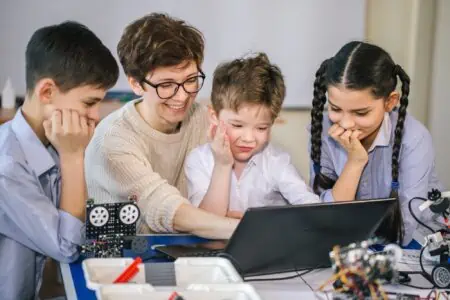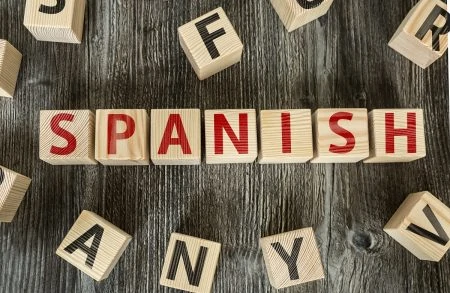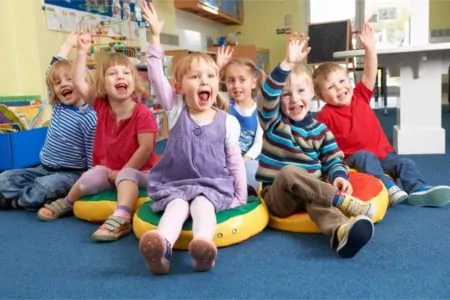We have curated a list of 20 brilliant coding websites that cater to everyone from kindergarteners to college-bound teens. Whether you are looking for free games to test the waters or structured paid courses for deep learning, we have you covered.
I have dug through the options to find the platforms parents and educators trust the most. Let’s dive in and transform that passive screen time into active skill-building.
Best Coding Websites for Kids
- Scratch: Best for creative freedom and community sharing.
- Blockly: Best for visual learners preparing for text coding.
- Code.org: Best for recognizable characters (Minecraft, Star Wars).
- CodeWizardsHQ: Best for live, teacher-led instruction.
- Tynker: Best for self-paced, gamified learning.
- Kodable: Best for pre-readers and elementary students.
- CodeCombat: Best for gamers who want to learn Python.
- Codecademy: Best for older teens wanting career-ready skills.
Free Coding Websites and Programs for Kids
You do not have to open your wallet to get a world-class education in programming. I have found and tested 10 excellent free coding websites for kids. These are brilliant for introducing your child to the concepts of logic and loops without any financial commitment.
To make your decision easier, I have broken down what to expect, the pros and cons, and why each platform is a winner for young learners.
Let’s get into it.
1. Scratch
Scratch is the gold standard for free coding. Developed by MIT, it is the world’s largest coding community for children. It uses a colorful “block-based” system where kids drag and drop commands to create animations, games, and interactive stories. It is intuitive, safe, and wildly creative.
Pros
- Massive community: Kids can share projects and “remix” others’ code to learn how it works.
- Wide age range: Perfect for ages 8 to 16 (ScratchJr is available for ages 5-7).
- Skill building: Teaches logic, design, and problem-solving without syntax frustration.
- Accessibility: Available in over 70 languages and used in schools worldwide.
- Offline editor: You can download the app to code without an internet connection.
Cons
- No text coding: It does not teach “real” syntax like Python or Java.
- 2D limit: It is strictly for 2D animation and gaming, not 3D.
- Moderation reliance: While safe, the community aspect means kids can see comments from strangers.
What Makes It Great for Kids
Scratch treats coding like digital LEGO. It allows kids to express themselves visually before worrying about semicolons and brackets. Teachers love it because it fosters creativity alongside logic. If your child likes to draw, tell stories, or play games, Scratch is the ultimate sandbox to start their journey.
2. Blockly
Blockly isn’t just a website; it is the library that powers many other coding platforms. Google’s Blockly Games is a series of educational games that teach programming concepts. It acts as a bridge between block-based coding and actual text-based coding.
Pros
- Clean interface: No distractions, just focused logic puzzles.
- Translation tool: It shows you the actual JavaScript code generated by your blocks.
- Progressive difficulty: Concepts get harder as you move from “Puzzle” to “Pond.”
- Zero setup: Runs directly in the browser with no login required.
Cons
- Limited scope: It is more of a demo/puzzle set than a full creation engine.
- Steep learning curve: Later levels (like the Pond) can be quite difficult for beginners.
- Tech-heavy: Less focus on “fun” characters, more focus on pure logic.
Why It’s Great for Kids
Blockly is fantastic for the “technically minded” kid who wants to see how things work under the hood. The key feature here is the ability to see the generated JavaScript code in real-time. It demystifies the transition from dragging blocks to writing scripts, making it a powerful tool for kids aged 8 and up.
3. Code.org
If your child has done an “Hour of Code” at school, they likely used Code.org. This non-profit is backed by tech giants like Microsoft and Google. Their goal is to make computer science accessible to everyone, regardless of background. They use familiar faces, like characters from Minecraft, Star Wars, and Frozen, to make coding feel less like homework and more like play.
Pros
- Forever free: High-quality courses that cost nothing.
- Pop culture tie-ins: Kids learn with Anna, Elsa, and Angry Birds.
- Comprehensive path: Covers everything from pre-reader basics to AP Computer Science principles.
- Offline activities: “Unplugged” lessons teach logic without screens.
- Teacher support: Massive library of resources for classroom integration.
Cons
- Classroom focus: Designed largely for schools, so the UI can feel a bit academic.
- Pacing: Some kids might find the step-by-step tutorials a bit slow if they want to build freely.
Why It’s Great for Kids
Code.org is the most accessible entry point on this list. The “Hour of Code” tutorials are bite-sized (literally one hour) and give kids an immediate sense of accomplishment. It removes the intimidation factor by using characters they already love.
4. Code for Life
Code for Life was originally developed for schools in the UK but is available globally. It is a non-profit initiative designed to take a student from their very first block of code all the way to writing complex Python scripts.
Pros
- Game-based: Uses “Rapid Router” (a delivery truck game) to teach logic.
- Real Python: Seamlessly transitions kids from blocks to typing Python code.
- Open source: Completely free and community-driven.
- Structured levels: Hundreds of levels ensure steady progression.
Cons
- Visuals: The graphics are functional but simple compared to paid rivals.
- Limited variety: Focuses heavily on the routing game mechanic.
Why It’s Great for Kids
This platform is a hidden gem for learning Python. Many apps stay in the “block” phase too long, but Code for Life pushes students toward text-based coding at the right moment. It is perfect for kids aged 6 to 13 who enjoy puzzle-solving more than open-ended creativity.
5. CodeMonkey
CodeMonkey teaches text-based coding right out of the gate using a language called CoffeeScript (similar to JavaScript) and Python. You control a monkey trying to get bananas. It sounds simple, but it teaches serious programming concepts. Note that while there is a free trial and some free content, full access requires a subscription.
Good To Know
Pros
- Real syntax: Kids type code immediately, not just drag blocks.
- Engaging story: The quest for bananas keeps kids motivated level after level.
- Keyboard skills: Naturally improves typing speed and accuracy.
- Wide range: Courses available for kindergarten (CodeMonkey Jr.) through 8th grade.
Cons
- Freemium model: You will hit a paywall after the introductory levels.
- Linear: It is more about solving puzzles than building open-ended apps.
Why It’s Great for Kids
CodeMonkey bridges the gap between easy block coding and “scary” text coding. The game mechanics are so fun that kids often don’t realize they are writing actual code to solve the puzzles. It is excellent for building the discipline required for real-world programming.
6. App Inventor
Created by Google and now maintained by MIT, App Inventor lets kids create fully functional apps for Android devices. This is not a game; it is a powerful tool. If your child asks, “How do I make an app for my phone?” this is the answer.
Pros
- Tangible results: Kids can install the apps they make on their actual phones.
- Visual interface: Uses block-based coding to handle complex logic.
- High ceiling: Capable of using GPS, sensors, and databases.
- Tutorials: Extensive library of step-by-step guides.
Cons
- Android focused: Testing on iOS is possible but more complicated than Android.
- Complex UI: The interface looks a bit dated and utilitarian.
- Age restriction: Best for middle schoolers and up; too complex for little kids.
Why It’s Great for Kids
This is project-based learning at its finest. Instead of solving abstract puzzles, kids build useful tools, like a text-to-speech app or a location-based game. It empowers them to become creators of technology rather than just consumers.
7. VEXcode VR
Robotics is expensive, but VEXcode VR makes it accessible to everyone. It allows students to code a virtual robot to navigate 3D playgrounds. You get the thrill of robotics without buying a $300 kit.
Pros
- Zero cost: No robot or software installation needed.
- Dual languages: Switch between Blocks and Python text coding.
- Instant feedback: See your robot crash or succeed immediately in the 3D window.
- Physics engine: Teaches sensors, velocity, and spatial reasoning.
Cons
- Niche appeal: Strictly focused on robot movement and sensors.
- Browser heavy: Requires a decent internet connection to run the simulation smoothly.
Why It’s Great for Kids
VEXcode VR is fantastic for visual learners who want to see their code have a physical effect. It is also a safe playground, if your code fails, the virtual robot just bumps a wall; nothing breaks. It is a perfect stepping stone into high school robotics clubs.
8. CodeCombat
CodeCombat turns learning Python and JavaScript into a dungeon-crawler RPG. Players write code to control their hero, attack enemies, and avoid traps. It is one of the most engaging ways to practice syntax.
Pros
- Gamified: It feels like a real video game, complete with loot and equipment.
- Real languages: Focuses on Python, JavaScript, and C++.
- Immediate context: You type
hero.attack()and your character swings a sword. - Competitive: Includes an AI league where kids code strategies to battle others.
Cons
- Paywall: The core levels are free, but advanced worlds require a subscription.
- Reading heavy: Requires typing and reading; not for pre-readers.
Why It’s Great for Kids
For the gamer kid who refuses to do “school work,” CodeCombat is the trojan horse of education. The fantasy setting hooks them, but the repetition of typing syntax builds muscle memory for real coding.
9. Code Monster
Code Monster is a minimalistic, no-frills tutorial for JavaScript. A friendly blue monster gives prompts, and the code you type instantly changes the visuals on the screen. It is old-school but effective.
Pros
- Instant gratification: Change a number in the code, and the box on screen grows immediately.
- No login: Just open the URL and start typing.
- Focus: No distracting animations or heavy graphics.
Cons
- Dated design: It looks like a website from the early 2000s.
- Zero hand-holding: If you get stuck, there are limited hints.
- Short: It is a quick intro, not a full curriculum.
Why It’s Great for Kids
It reduces coding to its simplest form: cause and effect. It is a great 20-minute activity for a rainy afternoon to see if your child has an aptitude for scripting.
10. Codecademy
Codecademy is the industry standard for self-taught coding. While aimed at adults, the free introductory courses are perfect for motivated high schoolers. It offers interactive, text-based lessons in almost every major language.
Pros
- Industry relevant: Teaches the exact languages used by Facebook and Google (Python, Java, React).
- Interactive terminal: You type code into the browser and run it instantly.
- Vast library: Covers web development, data science, and more.
Cons
- Dry: No games or characters; it is pure learning.
- Pro features: Quizzes, projects, and certificates are locked behind a paid subscription.
Why It’s Great for Kids
This is for the serious teen who is ready to build a portfolio. If your child wants to build a real website or analyze data, Codecademy is the best free place to start. It treats them like adults, which many teenagers appreciate.
Paid Coding Websites and Programs for Kids
If you want live instruction, structured curriculum, or certificated pathways, paid programs are often the better route. These options provide the mentorship and depth that free apps sometimes lack.
11. Create & Learn
Create & Learn focuses on the cutting edge of technology. Their curriculum goes beyond basic coding to include AI (Artificial Intelligence), Data Science, and even robotics. The classes are small, live, and led by expert instructors.
Pros
- Expert design: Curriculum created by tech insiders from Google and Stanford.
- Live interaction: Small groups (max 5 students) ensure personalized attention.
- Broad topics: Classes on Minecraft modding, Scratch, Python, and AI.
- Social: Kids can interact with peers, making it less isolating than self-paced video lessons.
Cons
- Schedule commitment: You have to show up at specific times.
- Cost: It is an investment compared to on-demand video courses.
Why It’s Great for Kids
If you want your child to understand how technology works, not just how to use it, this is the program. The inclusion of AI and Data Science makes it incredibly relevant for the future job market.
12. Tynker
Tynker powers coding education for over 60 million kids. It offers a massive ecosystem of self-paced courses. Whether your kid wants to mod Minecraft, fly a drone, or build a website, Tynker has a dedicated track for it.
Pros
- Minecraft integration: One of the best platforms for learning to code via Minecraft modding.
- Progression: Seamlessly moves kids from block coding to Python and JavaScript.
- Apps: Great mobile apps for coding on tablets.
- Variety: Over 3,700 modules across different interests (art, music, game design).
Cons
- Auto-renewal: Subscription models can be tricky if you forget to cancel.
- Less human support: Primarily self-paced, so kids need self-discipline.
Why It’s Great for Kids
Tynker is the “Netflix of coding.” The sheer volume of content means your child will never run out of things to do. The ability to mod Minecraft is a huge hook that gets reluctant coders interested immediately.
13. CodaKid
CodaKid creates courses that teach kids to use professional-grade tools. Instead of a “sandbox” environment, they teach kids how to write code for Minecraft, Roblox, and Unity using the real software developers use.
Pros
- Real tools: Kids learn to use Eclipse, IntelliJ, and Visual Studio.
- Roblox & Minecraft: Capitalizes on the games kids already play 24/7.
- Self-paced: Video tutorials allow kids to pause, rewind, and re-watch.
- Support: While self-paced, they offer chat support if you get stuck on a bug.
Cons
- Setup time: Installing real development environments can be tricky for non-tech parents.
- Hardware specs: You need a decent computer to run tools like Unity or Unreal Engine.
Why It’s Great for Kids
It treats kids like mini-professionals. By the end of a course, they aren’t just good at “CodaKid”, they are good at Java or Lua. It creates a very smooth transition to actual software development.
14. Kodable
Kodable is the champion of early education. Designed for ages 4 to 10, it is used in 50% of US elementary schools. It focuses on the fundamental logic of programming (sequence, conditions, loops) without requiring strong reading skills.
Pros
- Pre-reader friendly: Uses symbols and colors, perfect for kindergarteners.
- FuzzFamily: adorable characters make the experience feel like a Saturday morning cartoon.
- Transition: Upper levels introduce basic JavaScript and HTML/CSS.
- Parent dashboard: easy to track your child’s progress.
Cons
- Young audience: Kids over 10 will find the aesthetics too babyish.
- Tablet focus: The web experience is good, but it shines on an iPad.
Why It’s Great for Kids
It removes the frustration of typing. Many kids understand the logic of coding before they have the fine motor skills to type code. Kodable bridges that gap beautifully.
15. Code Avengers
Based in New Zealand, Code Avengers offers a slick, story-driven curriculum. It separates content into “Junior” (ages 5-14) and “Pro” (15+), covering everything from basic literacy to full-stack web development.
Pros
- Career focus: The Pro courses are rigorous and aimed at job skills.
- Interactive: Less video watching, more doing.
- Story modes: Junior courses use narratives to keep kids engaged.
Cons
- Price: It is on the higher end of the subscription spectrum.
- Text-heavy: The Pro courses involve a lot of reading.
Why It’s Great for Kids
It is a comprehensive platform that grows with your child. You can start them on the fun, story-based Junior tracks and eventually move them to the Pro tracks that are legitimate prep for computer science degrees.
16. Coding With Kids
This academy offers a “Coder’s Ladder” curriculum. It is structured like a martial arts belt system, where students advance from beginner to master. They offer both self-paced options and live, instructor-led classes.
Pros
- Structured path: Parents know exactly where their child stands and what is next.
- Small classes: Live instruction ensures kids do not get left behind.
- Variety: Covers Scratch, Python, Java, and even Amazon Alexa programming.
Cons
- Scheduling: Live classes require a fixed weekly commitment.
- Rescheduling policies: Can be strict if you miss a class.
Why It’s Great for Kids
The “ladder” system is highly motivating. Kids love leveling up and earning their next “rank.” It provides a clear sense of progression that random YouTube tutorials cannot match.
17. CodeWizardsHQ
CodeWizardsHQ is one of the most respected online coding schools. They offer a comprehensive, multi-year curriculum for elementary, middle, and high school students. The key differentiator? Every single class is live and taught by a real teacher.
Pros
- 93% completion rate: The live format keeps students accountable and engaged.
- Homework help: Students get access to daily live support hours.
- Real-world projects: Kids build portfolio-worthy websites and apps.
- Internship program: Advanced high school students can apply for a real-world internship.
Cons
- Cost: It is a premium service with a monthly tuition fee.
- Fixed schedule: You attend class at the same time every week (though makeup options exist).
Why It’s Great for Kids
If you want the structure of a private school class from the comfort of your home, this is it. The curriculum is seamless; students don’t just learn random skills, they follow a path that builds year over year. The internship opportunity for teens is a massive bonus for college applications.
18. Codemoji
Codemoji takes a unique approach: it teaches syntax using emojis. Instead of typing complex `
Pros
- Visual syntax: Eliminates syntax errors so kids focus on structure.
- Affordable: Generally cheaper than major competitors.
- Web focus: excellent introduction to web design (HTML/CSS).
Cons
- Limited depth: Great for basics, but eventually, you have to type real code.
- Niche: Mostly focused on web technologies.
Why It’s Great for Kids
It is fun! Using emojis makes the code look friendly rather than intimidating. For visual learners who get scared off by walls of text, Codemoji is a gentle and effective entry point.
19. CodeSpark
CodeSpark Academy is 100% word-free. It uses a cast of lovable monsters called “The Foos” to teach Boolean logic, loops, and sequencing. Because there is no text, a 5-year-old can learn to code before they can read a full sentence.
Pros
- Word-free: Accessible to pre-readers and kids with reading difficulties.
- Gender neutral: Specifically designed to appeal equally to girls and boys.
- Creative: Kids can design their own video games and share them.
Cons
- Ceiling: Great for K-5, but older kids will max it out quickly.
- Subscription: Requires a monthly fee after the trial.
Why It’s Great for Kids
It turns coding into a puzzle game. The “Game Maker” feature is particularly sticky, kids love playing games they built themselves. It creates a positive association with problem-solving from a very young age.
20. Vidcode
Vidcode targets a demographic often missed by gaming-centric apps: creative teens. It focuses on multimedia. Students learn to code by creating video filters, memes, and augmented reality effects, things they actually use on social media.
Pros
- Creative focus: Connects coding to art, photography, and video.
- Social sharing: Projects are easily shared on TikTok or Instagram.
- JavaScript: Teaches real, text-based JavaScript.
Cons
- Specific niche: If your kid prefers building games over editing video, this isn’t for them.
- Teacher-centric: Often sold to schools, though individual plans exist.
Why It’s Great for Kids
It answers the question, “Why do I need to learn this?” Vidcode shows teens that coding is a creative tool, just like a paintbrush or a camera. It is especially effective for engaging girls in computer science, a group often underrepresented in the field.
How to Choose a Coding Program for Kids
With 20 options, analysis paralysis is real. Here are five practical tips to narrow it down:
- Check the “Vibe”: Does your child like structure or freedom? For structure, go with CodeWizardsHQ or Code.org. For freedom, go with Scratch or Tynker.
- Consider Typing Skills: If your child is under 7 or struggles with typing, stick to block-based platforms like Scratch or CodeSpark. Do not force text coding too early; it will just cause frustration.
- Use Free Trials: Almost every paid service offers a 7-day trial or a free intro class. Sign up for two or three and let your child decide which one “clicks.”
- Hardware Requirements: Some platforms (like CodaKid’s Unreal Engine courses) require a powerful PC. Others (like CodeMonkey) run on an iPad. Check your tech before you buy.
- End Goal: Are they doing this for fun, or do they want to be an engineer? Fun = Game-based (CodeCombat). Career = Curriculum-based (Code Avengers/Codecademy).
Best Coding Websites for Kids Based on Age
It is crucial to match the platform to your child’s maturity level. Here is a quick reference guide to help you sort through the list.
| Website/Program | Elementary | Middle School | High School | Paid | Free |
| Scratch | ✓ | ✓ | ✓ | ✓ | |
| Blockly | ✓ | ✓ | ✓ | ✓ | |
| Code.org | ✓ | ✓ | ✓ | ✓ | |
| Code for Life | ✓ | ✓ | ✓ | ✓ | |
| CodeMonkey | ✓ | ✓ | ✓ | ✓ | |
| App Inventor | ✓ | ✓ | ✓ | ||
| VEXcode VR | ✓ | ✓ | ✓ | ✓ | |
| CodeCombat | ✓ | ✓ | ✓ | ✓ | ✓ |
| Code Monster | ✓ | ✓ | ✓ | ||
| Codecademy | ✓ | ✓ | ✓ | ✓ | |
| Create & Learn | ✓ | ✓ | ✓ | ✓ | |
| Tynker | ✓ | ✓ | ✓ | ✓ | |
| CodaKid | ✓ | ✓ | ✓ | ✓ | |
| Kodable | ✓ | ✓ | |||
| Code Avengers | ✓ | ✓ | ✓ | ✓ | |
| Coding With Kids | ✓ | ✓ | ✓ | ✓ | |
| CodeWizardsHQ | ✓ | ✓ | ✓ | ✓ | |
| Codemoji | ✓ | ✓ | ✓ | ||
| CodeSpark | ✓ | ✓ | |||
| Vidcode | ✓ | ✓ | ✓ |









